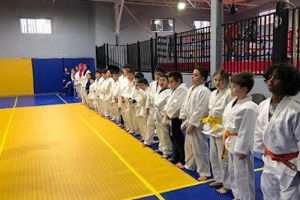Introductory courses in mixed martial arts provide foundational training in various combat disciplines, such as striking, grappling, and wrestling. These programs often cater to individuals with little to no prior experience in martial arts, focusing on fundamental techniques and physical conditioning appropriate for novices. A typical introductory session might involve learning basic punches and kicks, takedown defense, and introductory ground grappling techniques.
Foundational training in mixed martial arts offers numerous physical and mental benefits. Improved cardiovascular health, increased strength and flexibility, and enhanced self-confidence are common outcomes. Historically, mixed martial arts evolved from a confluence of different combat styles, gradually developing into a more codified sport with standardized rules and weight classes. This evolution has contributed to the rising popularity of structured training programs suitable for diverse populations.
This article will further explore the essential components of introductory mixed martial arts training, covering topics like choosing the right gym, essential equipment, and training frequency for optimal progress.
Tips for Starting Mixed Martial Arts Training
Embarking on mixed martial arts training requires careful consideration and preparation. The following tips offer guidance for individuals beginning this demanding yet rewarding journey.
Tip 1: Research and select a reputable gym. A qualified coaching staff with experience training beginners is crucial for safe and effective learning. Observe a class or two to assess the training environment and coaching style.
Tip 2: Start slowly and focus on proper technique. Mastery of fundamental movements is paramount. Avoid rushing into advanced techniques before building a solid foundation.
Tip 3: Prioritize consistent training. Regular attendance builds skill and conditioning. Even short, frequent sessions are more beneficial than sporadic intense workouts.
Tip 4: Listen to your body and respect its limits. Rest and recovery are as important as training itself. Pushing too hard, especially in the beginning, can lead to injuries.
Tip 5: Maintain proper nutrition and hydration. Fueling the body with a balanced diet supports optimal performance and recovery. Adequate hydration is essential, particularly during intense physical activity.
Tip 6: Supplement training with strength and conditioning exercises. Improved strength, flexibility, and endurance enhance overall performance in mixed martial arts.
Tip 7: Develop a positive and respectful training attitude. A supportive training environment fosters learning and growth. Respect for training partners and coaches is essential.
Adherence to these guidelines will contribute to a positive and productive training experience, fostering both skill development and physical well-being. A disciplined approach to training builds a strong foundation for long-term success in mixed martial arts.
By focusing on these fundamental principles, individuals can maximize their potential and enjoy the numerous benefits of mixed martial arts training.
1. Fundamental Techniques
Mastery of fundamental techniques is paramount in introductory mixed martial arts training. These foundational skills serve as the building blocks for more advanced maneuvers and contribute significantly to overall proficiency and safety. A strong grasp of these basics allows practitioners to develop a solid foundation for future growth in the sport.
- Stance and Footwork:
Proper stance and footwork are essential for maintaining balance, generating power, and creating openings for attacks. These skills enable efficient movement and defensive maneuvering within the training environment. For example, learning how to maintain a balanced fighting stance allows a beginner to react quickly to an opponents actions. Efficient footwork enables seamless transitions between offensive and defensive maneuvers.
- Basic Strikes:
Developing proficiency in fundamental striking techniques, such as jabs, crosses, hooks, and kicks, is crucial for effective offensive tactics. Precise execution of these techniques maximizes power and minimizes the risk of injury. For instance, a well-executed jab can disrupt an opponents rhythm, while a powerful cross can deliver significant force. Understanding proper striking mechanics is essential for both offensive and defensive strategies.
- Takedowns and Throws:
Learning basic takedowns and throws provides practitioners with the ability to control the fights location, transitioning from stand-up exchanges to ground grappling. These techniques require precise timing and leverage for successful execution. A double-leg takedown, for example, can effectively bring an opponent to the ground, creating opportunities for ground control and submissions.
- Basic Grappling and Escapes:
Foundational grappling skills, including basic submissions, escapes, and positional control, are vital components of mixed martial arts. These techniques equip practitioners with the ability to defend themselves on the ground and create opportunities for offensive maneuvers. Learning how to escape from a dominant position, such as the mount, is crucial for self-preservation and creating opportunities to regain control.
These core techniques form the bedrock of effective mixed martial arts training. Consistent practice and refinement of these fundamentals allow beginners to build a strong foundation, enabling them to progress to more complex techniques and develop a well-rounded skill set essential for success in the sport. This emphasis on fundamental techniques ensures a safe and effective learning experience, paving the way for continued growth and development in mixed martial arts.
2. Physical Conditioning
Physical conditioning forms a cornerstone of effective mixed martial arts training, particularly for beginners. Adequate physical preparation is essential for executing techniques, enduring demanding training sessions, and minimizing the risk of injury. A well-structured conditioning program complements technical skill development, ensuring participants possess the necessary strength, endurance, and flexibility to progress safely and efficiently.
- Cardiovascular Fitness:
Mixed martial arts training involves high-intensity intervals of exertion. Developing cardiovascular fitness is crucial for sustaining performance throughout training sessions and maintaining stamina during sparring or competition. Activities like running, swimming, and cycling enhance cardiovascular capacity, enabling individuals to train more effectively and recover more quickly.
- Strength Training:
Strength training enhances power generation for strikes, takedowns, and grappling maneuvers. Compound exercises like squats, deadlifts, and bench presses build foundational strength, improving overall performance in various aspects of mixed martial arts. Increased strength also contributes to injury prevention by strengthening supporting muscles and joints.
- Flexibility and Mobility:
Flexibility and mobility are crucial for executing techniques with proper form and range of motion. Regular stretching and mobility exercises enhance joint health, reduce the risk of muscle strains, and improve overall athleticism. Improved flexibility also contributes to executing techniques like kicks and submissions effectively.
- Endurance and Stamina:
Mixed martial arts training demands both muscular and cardiovascular endurance. Sustained exertion during grappling, striking exchanges, and rounds of sparring requires a high level of stamina. Interval training and circuit training, combining various exercises with short rest periods, are effective methods for developing both muscular and cardiovascular endurance.
These facets of physical conditioning are integral to success in beginner mixed martial arts classes. A comprehensive training program that addresses these elements ensures individuals develop the physical attributes necessary to meet the demands of the sport, progress effectively, and minimize the risk of injury. A balanced approach to physical conditioning complements technical skill development, creating a solid foundation for long-term growth and success in mixed martial arts.
3. Gym Selection
Appropriate gym selection holds significant weight in the context of introductory mixed martial arts training. The learning environment profoundly influences a beginner’s progress, safety, and overall experience. A suitable gym provides qualified instruction, appropriate training partners, and a supportive atmosphere conducive to learning. Conversely, an unsuitable training environment can hinder progress, increase injury risk, and potentially discourage continued participation. The cause-and-effect relationship between gym selection and training outcomes is undeniable. For instance, a gym with experienced coaches specializing in beginner instruction can instill proper techniques from the outset, minimizing the risk of developing bad habits that hinder future progress. Conversely, a gym lacking qualified instructors might lead to improper technique development and increased injury potential. Another example lies in the importance of a supportive training environment. A gym fostering camaraderie and mutual respect amongst training partners cultivates a positive learning experience, encouraging continued participation and growth. In contrast, a gym rife with negativity or ego can create a detrimental learning environment, potentially discouraging beginners.
The practical implications of careful gym selection are numerous. Consider a beginner with specific training goals, such as self-defense. Choosing a gym emphasizing practical self-defense techniques over competitive training would align more effectively with their objectives. Alternatively, an individual interested in competitive mixed martial arts should seek a gym with a proven track record of producing competitive athletes. Observing classes, speaking with current members, and researching the gym’s credentials are crucial steps in making an informed decision. Factors such as coaching experience, class structure, training equipment, and overall gym atmosphere warrant careful consideration. Understanding the nuances of gym culture and training methodologies aids individuals in finding an environment conducive to their individual needs and goals.
In summary, selecting a suitable training environment represents a pivotal decision for individuals embarking on mixed martial arts training. This choice directly impacts not only skill development and safety but also long-term engagement with the sport. Thorough research and careful consideration of individual needs and training goals are essential for maximizing the benefits and minimizing the risks associated with mixed martial arts training. The gym represents more than just a physical space; it forms the foundation upon which a beginner’s mixed martial arts journey is built.
4. Consistent Training
Consistent training forms the bedrock of progress in beginner mixed martial arts classes. A direct correlation exists between training frequency and skill development. Regular attendance reinforces learned techniques, builds muscle memory, and improves overall physical conditioning. Sporadic training, conversely, hinders progress, leading to slower skill acquisition and difficulty retaining previously learned material. For example, consistent practice of a specific takedown technique leads to improved execution speed, accuracy, and efficiency. Inconsistent practice, however, results in slower execution, decreased accuracy, and diminished effectiveness. The cause-and-effect relationship is clear: consistent effort yields consistent improvement.
The importance of consistent training extends beyond mere skill acquisition. Regular engagement in physical activity fosters discipline, improves cardiovascular health, and enhances overall well-being. These benefits contribute to increased self-confidence and a more positive self-image, reinforcing the value of consistent training within the broader context of personal development. Consider an individual struggling with self-discipline. Consistent attendance in mixed martial arts classes provides a structured environment fostering discipline and commitment, translating into positive changes beyond the gym. This demonstrates the practical significance of consistent training, impacting not only physical skills but also mental fortitude and personal growth.
In summary, consistent training represents a non-negotiable element of successful participation in beginner mixed martial arts classes. It serves as the catalyst for skill development, physical conditioning, and personal growth. Challenges such as scheduling conflicts or motivational barriers can impede consistent training. Overcoming these challenges, however, yields substantial rewards, solidifying the importance of consistent effort in realizing the full potential of mixed martial arts training. Consistent training is not merely a component of a successful training regimen; it is the cornerstone upon which progress is built.
5. Safety Precautions
Safety precautions constitute a critical aspect of beginner mixed martial arts classes. A direct link exists between adherence to safety protocols and injury prevention. Proper instruction, protective gear, and controlled training environments minimize the inherent risks associated with combat sports. Neglecting safety precautions, conversely, increases the likelihood of injuries, ranging from minor bruises and sprains to more severe concussions or fractures. For instance, consistently wearing appropriate hand wraps and gloves during striking practice significantly reduces the risk of hand and wrist injuries. Failing to utilize proper protective equipment elevates the likelihood of such injuries. The cause-and-effect relationship is clear: prioritizing safety mitigates risk.
The significance of safety precautions extends beyond immediate injury prevention. A safe training environment fosters confidence, allowing beginners to focus on learning techniques and developing skills without undue apprehension. This positive reinforcement loop encourages continued participation and promotes a more enjoyable training experience. Consider a beginner apprehensive about sparring due to perceived safety risks. A controlled sparring environment with clear rules, experienced supervision, and appropriate safety gear can alleviate these concerns, fostering a more positive and productive training experience. This illustrates the practical implications of prioritizing safety, impacting not only physical well-being but also psychological comfort and overall training efficacy.
In summary, safety precautions represent a non-negotiable element of beginner mixed martial arts classes. They form the foundation of a secure and productive training environment, directly impacting injury prevention and overall training experience. Challenges such as cost considerations or perceived inconvenience can sometimes hinder adherence to safety protocols. Overcoming these challenges, however, yields substantial benefits, reinforcing the paramount importance of safety in mixed martial arts training. Safety is not merely a component of effective training; it is the prerequisite upon which all other aspects of training are built.
6. Mindset and Discipline
Cultivating the correct mindset and discipline proves essential for navigating the challenges inherent in beginner mixed martial arts classes. A direct correlation exists between mental fortitude and successful training outcomes. A positive, resilient mindset enables individuals to overcome the physical and mental demands of training, fostering perseverance and promoting long-term commitment. Conversely, a negative or defeatist mindset can hinder progress, leading to discouragement and premature cessation of training. For instance, an individual approaching training with a growth mindset embraces challenges as opportunities for learning and improvement. This individual is more likely to persevere through difficult training sessions and experience consistent progress. Conversely, an individual with a fixed mindset may view challenges as insurmountable obstacles, leading to frustration and potentially abandoning training altogether. The cause-and-effect relationship is clear: mindset directly influences training outcomes.
The importance of discipline extends beyond mere attendance in training sessions. It encompasses consistent effort, adherence to instructions, and respect for training partners and coaches. Disciplined practice of fundamental techniques leads to improved skill acquisition and reduced risk of injury. Furthermore, disciplined adherence to strength and conditioning programs enhances physical preparedness and overall performance. Consider an individual diligently practicing a specific technique outside of scheduled class time. This extra effort demonstrates discipline and commitment, leading to accelerated skill development and a deeper understanding of the technique. This example highlights the practical significance of discipline, translating dedication into tangible progress.
In summary, mindset and discipline represent integral components of success in beginner mixed martial arts classes. They form the foundation of perseverance, resilience, and consistent effort. Challenges such as initial discouragement or lack of motivation can impede the development of a positive mindset and strong discipline. Overcoming these challenges, however, yields significant rewards, reinforcing the importance of mental fortitude in realizing the full potential of mixed martial arts training. Mindset and discipline are not merely desirable attributes; they are the essential catalysts for transformative growth and long-term success in the demanding yet rewarding journey of mixed martial arts.
Frequently Asked Questions
This section addresses common inquiries regarding introductory mixed martial arts training. The objective is to provide clear and concise information to alleviate common concerns and misconceptions.
Question 1: What level of fitness is required to begin mixed martial arts training?
While a base level of fitness is beneficial, introductory classes cater to various fitness levels. Programs typically begin with fundamental movements and gradually increase in intensity as fitness improves. Focus remains on proper technique and individual progress.
Question 2: Is mixed martial arts training dangerous?
All contact sports carry inherent risks. However, reputable training programs prioritize safety through structured instruction, protective gear, and controlled sparring environments. Adherence to safety protocols significantly mitigates potential risks.
Question 3: How frequently should one attend beginner classes?
Training frequency depends on individual goals and schedules. Two to three sessions per week generally provide sufficient training volume for beginners to progress effectively. Consistency is key for skill development and physical conditioning.
Question 4: What equipment is necessary for introductory mixed martial arts classes?
Gyms often provide basic equipment for beginners. As training progresses, individuals may choose to invest in personal gear such as gloves, hand wraps, shin guards, and mouthguards. Consult with instructors for specific equipment recommendations.
Question 5: How long does it take to see progress in mixed martial arts?
Progress varies based on individual aptitude, training frequency, and commitment. Generally, individuals can expect to see noticeable improvements in technique, fitness, and overall skill within a few months of consistent training.
Question 6: Are there age restrictions for beginner mixed martial arts classes?
Many gyms offer programs for children, adolescents, and adults. Age-specific classes ensure appropriate training methodologies and safety protocols for different developmental stages. Consult with individual gyms regarding specific age requirements and program offerings.
This information addresses some common concerns surrounding introductory mixed martial arts training. Further inquiries should be directed to qualified instructors at reputable training facilities.
The next section delves into advanced training methodologies for individuals seeking to progress beyond the fundamentals.
Conclusion
Introductory mixed martial arts training provides a structured pathway for acquiring fundamental combat skills, enhancing physical fitness, and cultivating discipline. Careful consideration of gym selection, consistent training, adherence to safety protocols, and development of a positive mindset are crucial for maximizing training outcomes and minimizing risks. This exploration has highlighted the essential components of effective introductory training, emphasizing the interconnectedness of technical skill development, physical conditioning, and mental fortitude.
The journey into mixed martial arts, beginning with introductory training, offers significant potential for personal growth and transformation. Diligent practice, coupled with a commitment to continuous learning, unlocks numerous physical and mental benefits. This pursuit empowers individuals to cultivate self-confidence, resilience, and a deeper understanding of self-defense principles. Introductory mixed martial arts training serves not merely as an introduction to a sport, but as a gateway to personal empowerment and lifelong learning.







